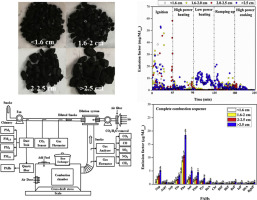Journal of the Energy Institute ( IF 5.6 ) Pub Date : 2019-07-08 , DOI: 10.1016/j.joei.2019.06.010 Nan Zhao , Bowen Li , Deying Chen , Tohniyaz Bahargul , Rui Wang , Yuguang Zhou , Harold John Annegarn , Crispin Pemberton-Pigott , Renjie Dong , Xinxin Ju

|
Residential coal combustion has played an important role in the domestic energy supply of Northern China for many decades and will do so for the foreseeable future, although it is also an important contributor to severe air pollution. Meeting the daily cooking and spacing-heating demands of rural residents in an eco-friendly manner necessitates cleaner-burning technologies for residential coal combustion. Several reports have suggested that appropriately sized coal be beneficial for optimizing the performance of domestic coal-fired stoves. The effects of coal size (<1.6 cm, 1.6–2.0 cm, 2.0–2.5 cm and >2.5 cm) on fine particulate matter (PM2.5) and sixteen U.S. Environmental Protection Agency (EPA) priority polycyclic aromatic hydrocarbons (16-PAHs) emissions from a natural cross-draft stove, operating in different phases (ignition, high power heating, low power heating, ramping up and high power cooking) were analyzed in this study. Results indicated that decreasing the coal size enhanced thermal efficiency and reduced pollutant emissions. When the coal size decreased from >2.5 cm to <1.6 cm, the average emission factor (EF) of PM2.5 over a complete combustion sequence decreased from 3.12 to 1.42 mg/MJnet, and the EF of PM-bound total PAHs decreased from 44.9 to 10.9 μg/MJnet. The corresponding toxic equivalent quantity (TEQ) decreased from 1.25 to 0.38 μg/MJnet. Emissions and energy efficiencies varied markedly between the various combustion phases, adequate air supply during the high power heating and cooking phases reduced the EFs of PM2.5 and PAHs, while the low power heating phase produced relatively more pollutants due to a fuel-rich condition.











































 京公网安备 11010802027423号
京公网安备 11010802027423号